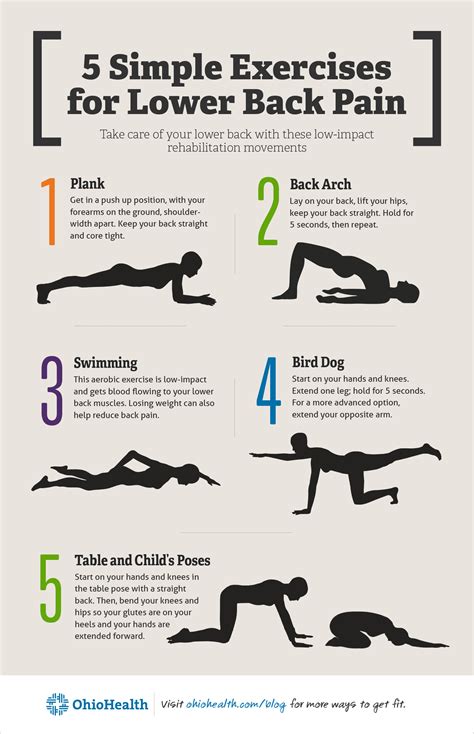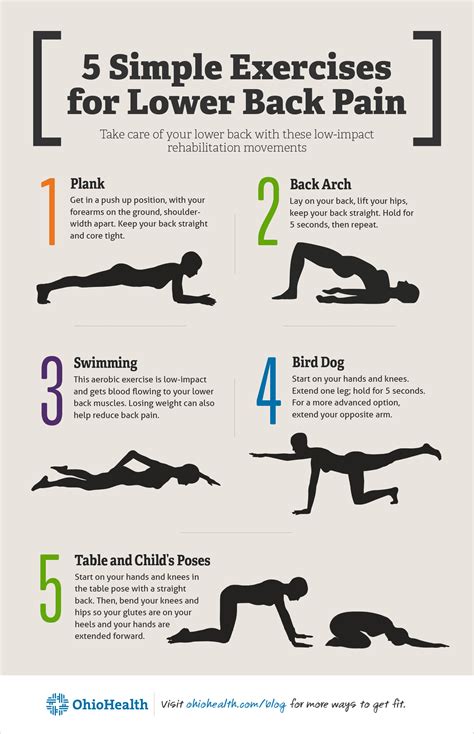Intro
Relieve lower back pain with 5 effective exercises, targeting core strength, flexibility, and spinal stability, to improve posture and overall back health through regular physical therapy and workout routines.
Lower back pain is a common issue that affects millions of people worldwide, causing discomfort, limiting mobility, and affecting overall quality of life. Engaging in regular lower back exercises can help alleviate pain, improve flexibility, and strengthen the muscles that support the spine. In this article, we will explore the importance of lower back exercises, their benefits, and provide a comprehensive guide on how to incorporate them into your daily routine.
The lower back, also known as the lumbar region, is a complex area that consists of five vertebrae, muscles, ligaments, and tendons. When these structures are weak or imbalanced, it can lead to poor posture, strain, and injury. Regular exercise can help maintain a healthy lower back by improving flexibility, strengthening the core muscles, and enhancing posture. Furthermore, lower back exercises can also reduce the risk of chronic pain, improve sleep quality, and boost overall physical and mental well-being.
Lower back exercises are not just limited to people who experience pain or discomfort. They are essential for anyone who wants to maintain a healthy back, improve their overall fitness, and reduce the risk of injury. Whether you are an athlete, a busy professional, or a stay-at-home parent, incorporating lower back exercises into your daily routine can have a significant impact on your quality of life. In the following sections, we will delve into the benefits, working mechanisms, and steps involved in performing effective lower back exercises.
Benefits of Lower Back Exercises

Types of Lower Back Exercises
There are various types of lower back exercises that can be performed to achieve these benefits. These include: * Stretching exercises to improve flexibility and reduce muscle tension * Strengthening exercises to build core muscle strength and enhance posture * Aerobic exercises to improve cardiovascular health and reduce inflammation * Functional exercises to improve coordination, balance, and overall physical function5 Effective Lower Back Exercises

Precautions and Modifications
It is essential to take precautions and modify the exercises to suit your individual needs and abilities. Some precautions to keep in mind include: * Consulting with a healthcare professional before starting any new exercise program * Listening to your body and stopping if you experience any pain or discomfort * Modifying the exercises to suit your fitness level and abilities * Warming up before exercising and cooling down afterwards to prevent injuryCommon Mistakes to Avoid

Tips for Incorporating Lower Back Exercises into Your Daily Routine
Incorporating lower back exercises into your daily routine can be challenging, but there are tips to help you stay on track. These include: * **Scheduling it in**: Treat exercise as a non-negotiable part of your daily routine, just like brushing your teeth or taking a shower. * **Finding a workout buddy**: Exercising with a friend or family member can help keep you motivated and accountable. * **Tracking your progress**: Keeping a workout journal or using a fitness app can help you track your progress and stay motivated. * **Rewarding yourself**: Rewarding yourself for reaching milestones or completing a challenging workout can help keep you motivated and engaged.Conclusion and Next Steps

We invite you to share your thoughts, experiences, and tips on lower back exercises in the comments section below. If you found this article helpful, please share it with your friends and family who may benefit from this information. Take the first step towards a healthier, happier you by incorporating lower back exercises into your daily routine today!
What are the most common causes of lower back pain?
+Lower back pain can be caused by a variety of factors, including poor posture, muscle strain, herniated discs, and degenerative conditions such as osteoarthritis.
How often should I perform lower back exercises?
+It is recommended to perform lower back exercises 2-3 times per week, with at least one day of rest in between. However, the frequency and intensity of the exercises may vary depending on your individual needs and abilities.
Can lower back exercises help alleviate chronic pain?
+Yes, lower back exercises can help alleviate chronic pain by strengthening the muscles that support the spine, improving flexibility, and reducing inflammation. However, it is essential to consult with a healthcare professional before starting any new exercise program, especially if you are experiencing chronic pain.
